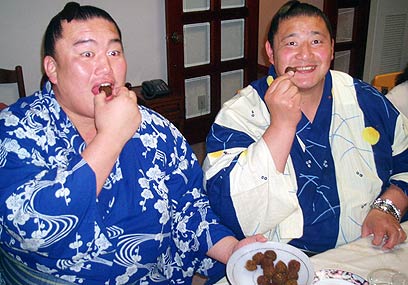 Lucky me! What a treat: last night, a Valentine's day dinner courtesy of Mark Bittman. Tonight, just shortly ago, a portage dinner of salmon nabe. The latter was courtesy of my friends C. and E., who came over for a visit and brought an entire supper with them. What a lovely way to close the week. Two gifts, two nights in a row. In each case, a magical influx of energy and ideas.
Lucky me! What a treat: last night, a Valentine's day dinner courtesy of Mark Bittman. Tonight, just shortly ago, a portage dinner of salmon nabe. The latter was courtesy of my friends C. and E., who came over for a visit and brought an entire supper with them. What a lovely way to close the week. Two gifts, two nights in a row. In each case, a magical influx of energy and ideas.Yesterday, H. forwarded Bittman's February 13th "Minimalist" column on short ribs braised in coffee, red wine, and chilies. Since we often have leftover coffee these days— we don't work at home much any more, so we rarely finish a pot— this dish virtually begged us to make it.
Braised beef chunks often end up tasting like Beef Bourguignon, regardless of your intentions. You can select different sizes and shapes of meat, and you can add various degrees of aromatic fanfare. But in the end, you wind up with winey-flavored beef.
I like winey-flavored beef; don't get me wrong. But it does lean toward the monochromatic.
The coffee and chile solution is a welcome intervention. I thus recommend this recipe for any occasion that calls for a modest change of pace. I recently made short ribs braised in ginger and porter, and there's a similar bitterness at work here. But in the Bittman recipe the chilies-- smoky chipotles and pasillas-- complement the coffee's bitterness with a rich bouquet of spice and warmth.
The recipe-- here it is-- is quite simple, so I won't bother reiterating it. One thought for the future, though, is how best to accompany this dish, since its braising liquid cries out for starchy accompaniment. We served it with beans and rice, but that was determined largely by circumstance: the beans and rice were holdovers from the previous night's dinner. I would think that homemade corn tostones would work nicely, or even something involving plantains. A flavorful starch— smoky tamales, even— would frame the ribs well.
*** Part II ***
With H. off to visit C-Spice and Schooly in Cincinnati for the weekend, I had been facing the prospect of cooking for one (or for 1.5, with little A. nibbling at the corners). Such conditions often yield empty dinners of cereal and beer. So it was with no small amount of pleasure-- and relief-- that my evening guests C. and E. came equipped with the makings of a marvelous nabe.
 Nabe, in its highest form, is Sumo food. In principle it's a Japanese bouillon made from three simple ingredients: water, sake, and miso paste. The flavor becomes increasingly complex as additional ingredients are added to the pot. Tonight's featured additions were daikon radish, fingerling potatoes, carrots, onions, and shungiku (chrysanthemum greens); tofu; and assorted seafood.
Nabe, in its highest form, is Sumo food. In principle it's a Japanese bouillon made from three simple ingredients: water, sake, and miso paste. The flavor becomes increasingly complex as additional ingredients are added to the pot. Tonight's featured additions were daikon radish, fingerling potatoes, carrots, onions, and shungiku (chrysanthemum greens); tofu; and assorted seafood.In C.'s preparation, the ingredients arrived pre-cut and beautifully arranged in a bountiful mise-en-place. After bringing the broth to a boil in a traditional earthenware pot, she added the root vegetables. Then, about ten minutes later, she added the greens, as well (I think) as the tofu. Ten minutes later, she added cubed salmon and shrimp, simmered the whole dish for about five minutes, and brought it to the table.
In the collective Sumo-workshop mode of cooking, items can be thrown into the bouillon at will, since the broth is still cooking actively throughout the meal. It's hard to replicate this at home, especially given our relative lack of floor space. So C.'s nabe was a singular event, rather than an odyssey of dunking and boiling that might unfold throughout an evening. Yet it was no less playful for its simultaneity-- nor any less delicious. Poor H. missed out: these were the "clean flavors" she so heartily enjoys.
All the same, H. won't mourn. Thanks to a canceled flight, she's stuck in Philly tonight, and can thus go to Tacqueria Veracruzana instead. So she can find consolation in carnitas.

No comments:
Post a Comment